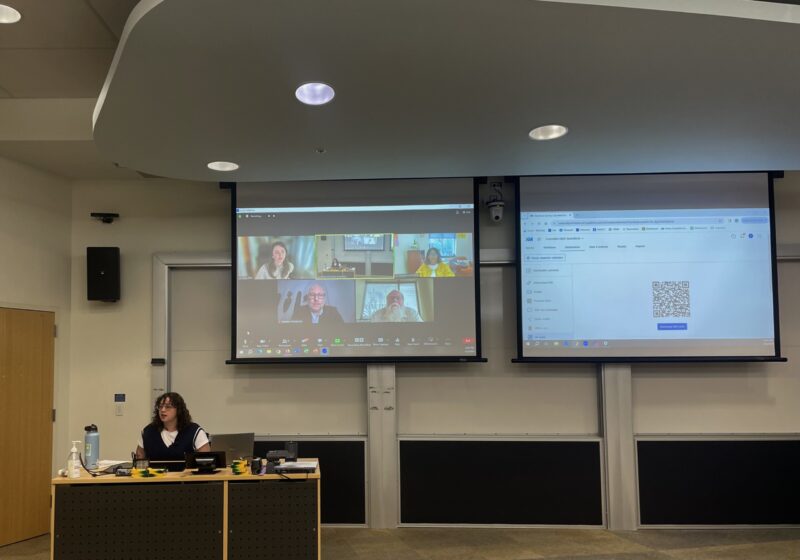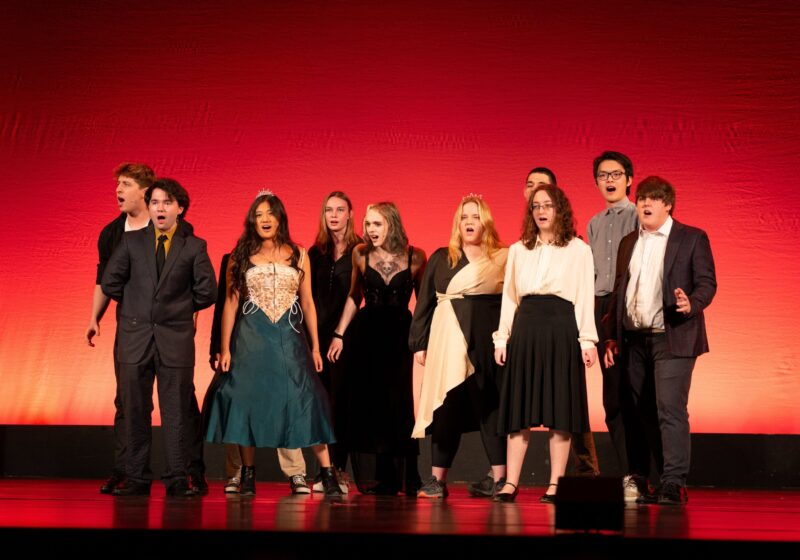 “A carillon is a set of tuned bells. It must have at least 23 bells to be a carillon; otherwise it’s a chime. Ours has 50.” Junior Kara Morse sits across from me on a couch in Gleason. This semester’s Carillon Society general interest meeting has just concluded and most of UR’s student carillonneurs have dispersed. But Morse, along with sophomores Sarah Lamade and Kiara Osolinsky, has agreed to stick around to share her knowledge about the unique instrument housed in the Rush Rhees tower. The one anyone who’s been on campus for more than 15 minutes has heard but very few have heard of – I certainty hadn’t.
“A carillon is a set of tuned bells. It must have at least 23 bells to be a carillon; otherwise it’s a chime. Ours has 50.” Junior Kara Morse sits across from me on a couch in Gleason. This semester’s Carillon Society general interest meeting has just concluded and most of UR’s student carillonneurs have dispersed. But Morse, along with sophomores Sarah Lamade and Kiara Osolinsky, has agreed to stick around to share her knowledge about the unique instrument housed in the Rush Rhees tower. The one anyone who’s been on campus for more than 15 minutes has heard but very few have heard of – I certainty hadn’t.
So what exactly is a carillon? It’s a system of bells, tuned to play several octaves of notes. Each bell is rung by an individual “clapper” that is connected to a wire. These wires, in turn, are connected to an apparatus of wooden batons that vaguely resemble a double-decker keyboard. When a carillonneur (a carillon musician) strikes a baton with the heel of their loosely clinched fist or the ball of their foot, a wire is pulled, a clapper is shifted, and a bell is rung, treating all those in the vicinity to the enchanting tones of the carillon.
It should be noted that a carillonneur does not permanently preside in the library tower, striking a baton four times an hour to keep students on time. No, an automated system is responsible for the carillon’s time keeping duties. But every time music is heard resonating from the lantern atop the Rush Rhees dome, a person – a student – is playing.
According to Lamade, carillon is all in the wrists – “you have to throw them in a weird circular motion” she laughs. But playing the carillon isn’t just up to wrists and fists – carillonneurs are also responsible for a substantial pedal board that generates the tones of the lowest two octaves of bells. Customarily, carillon players remove their shoes when playing, allowing for a better “feel” of the pedals.
“It’s a very powerful instrument,” Morse explains, describing playing as a “physical workout.” “It’s an instrument you wouldn’t normally get to play.”
Morse’s words couldn’t be more true. There are only 160 carillons in the entire U.S and UR’s carillon is one of just seven in New York State. So it’s no surprise that most people haven’t heard of this Netherland native instrument. Most of the current members of Carillon Society hadn’t heard of it before coming to UR either.
Morse first learned about the carillon during the spring of her freshmen year through a physics TA. Intrigued, she emailed Doris Aman, the University’s carillon instructor and Carillon Society advisor. Aman’s response: “Just show up.” Three semesters later, Morse has learned a lot, both from Aman and her more experienced peers, but continues to practice on a regular basis. A carillon practice room is conveniently located in Spurrier, allowing new students to hone their skills before heading up the library tower to play for the entire UR community to hear.
If you’re wondering, no, there is not an entire carillon hidden inside Spurrier – instead, a carillon keyboard apparatus, known as a “clavier,” is attached to a glockenspiel, an instrument similar to a xylophone, located near the piano rooms. “It sounds very different from the actual carillon,” Osolinsky laments. She brightens, however, as she brings up “Tower Times” – when members of the Carillon Society are allowed to ascend the library’s tower to play the real carillon.
UR’s Hopeman Memorial Carillon was installed in Rush Rhees in 1973, replacing an original chime of 17 bells that, after 40 years, was beginning to deteriorate. The chime, brought to the University in 1930 as a finishing touch to the newly opened library, was much heavier than the carillon bells that currently hang in the tower – nearly 20 tons heavier. The keyboard was smaller and electronic, as opposed to the fully mechanical nature of carillons. And while official bellmen were appointed to treat the University to music until the ‘50s, playing conditions were less than ideal.
So as not to distract diligent studiers, Rush Rhees is soundproof. The bells of the tower cannot be heard inside the library, not even from inside the lofty room that housed the chime’s keyboard or the cabin below the bells that contains the current carillon clavier. Today, UR carillonneurs have solved this inconvenience through the use of a microphone system that Morse assures me is very good: “there’s no lag, it sounds instantaneous.” The bellman of the past, however, were not so lucky, forced to open a window in their little room to letting in the music – along with the elements.
When the University’s second faculty bellman stepped down in 1949, it was suddenly up to the students to keep the music going and the Bellmen Society (changed to the Bellmen and Bellwomen Society when the University became co-ed) was born. From this legacy came the Carillon Society – a group of students dedicated to learning, teaching, and playing the Carillon. The group remained active until the early 2000s, when their advisor moved to Yale, leaving no one to take his place, and everything went silent.
That is, until KEY scholar Jeff Le joined with Eastman organist Tiffany Ng in 2008 to revitalize the Carillon Society. Both experienced carillonneurs, Le and Ng, began performing regularly, reminding the University of its dormant treasure. Le and Ng hoped to create a legacy of carillon players at UR, envisioning a time when more experienced carillonneurs would begin teaching interested underclassmen, carrying on the tradition of carillon music on campus. For the last five years, this has largely come to fruition, but not without the help of Doris Aman.
Aman, who just recently adopted the title of adjunct instructor within the University’s music department, teaches the art of carillon to students each year and has built the Carillon Society up to a respectable 30 members. As of last semester, she has even begun to teach for-credit carillon classes. “The credit courses are new this year and going to be for students with some keyboard background,” she tells me, back in Gleason after retrieving some sheet music. She has a lesson soon. “The idea is, one way or another, for students to be learning so that [they] are the ones playing.” “It’s not a faculty position.”
Aman is always excited to welcome any student interested in carillon and there is no requirement for taking lessons from peer mentors. “Anybody can do it – half the people that play are physics students,” Morse tells me. Lamade agrees, adding that “some [of the players] literally start from scratch” with no music experience whatsoever. Lamade explains that mentor lessons are part of a “student leadership program.” Students must go through a rigorous process to become carillon mentors, attending at least ten lessons, giving two public performances, volunteering ten service hours to the university music department, undergoing safety training, and completing a peer-judged audition. But along with the joy of teaching fellow carillon enthusiasts, mentors get the special privilege of ascending to the carillon cabin buddied with fellow trained and qualified mentors to play for the campus without Aman’s supervision.
For those hoping for slightly more advanced instruction and an education on carillon history, Aman now offers two courses to UR students – one worth two credits and one worth four. Both require weekly lessons, participation in concerts, and consistent practice. This semester, eight students are enrolled.
During the school year, the Carillon Society makes use of its instrument through informal student performances and several organized events including Scare Fair, Meliora Weekend, and graduation. The pieces selected for informal concerts include holiday themed songs, student creations, and special requests, played weekly for the benefit of the UR student body.
Summer is when the Hopeman Memorial Carillon has its most attentive audience, however. “We’ve had some of the best in the world,” Aman tells me, referring to the annual July carillon concert series that takes place on campus. Professional carillonneurs perform weekly at the University, sharing their talents and treating the beautiful tones of the carillon to anyone in the Rochester community who cares to listen.
The Hopeman Memorial Carillon is an important part of UR’s history, kept alive today by an ever-ambitious group of students that have dared to try something new and share what they have learned with those around them. Most UR students know little of the origin of the bell music they hear drifting across campus as they shuffle between classes. Most probably chalk it up to the seemingly magical world that is UR. Nevertheless, those behind the tones, the Carillon Society, hope to keep the music, if not the mystery, going for many years to come.
Students interested in learning more about Carillon Society and the history of UR’s carillon can visit the Hopeman Memorial Carillon webpage on rochester.edu, join the UR Carillon Society facebook group, like their page, or email Doris Aman at doris.aman@gmail.com.
Rudd is a member of the class of 2017.





